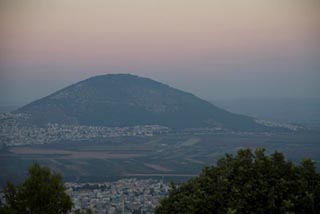5:1–15 The indictment that the prophet presented in Hos 4 now culminates in a guilty verdict directed at the priest and the king, who have led Israel into idolatry. The prophet then focuses on the divine wrath coming on both Israel and Judah. The historical setting seems to relate to the time of the Syro-Ephraimite War (circa 735–732 bc). See note on Isa 7:1. |
5:1 judgment Used in the sense of a legal verdict and sentence.
Mizpah A city in the territory of Benjamin on the border with Israel. See note on Jer 40:6.
Tabor A mountain on the northern side of the Jezreel Valley. See note on Jer 46:18.
5:3 I myself know Contrasts with Hos 5:4. Yahweh knows Israel and its actions, but it does not know Him.
Ephraim Refers here to the whole northern kingdom. See note on 4:17.
you have played the whore Hosea uses this idiom nine times to describe Israel’s idolatry.
5:4 a spirit of whoredom Refers to the spirit of idolatry that has become so pervasive in the land. The reference to a ruach (wind or spirit) in 4:19 probably also reflects this idea.
5:6 he has withdrawn from them The worship at Israel’s local shrines will be fruitless, since there is no divine power there. The people mistook Yahweh’s blessing for that of their idols, so He will withdraw that blessing (compare 2:5, 8).
5:7 illegitimate children These children are unknown to Yahweh, who renounces any responsibility to care for them. Reflects Hosea’s situation with his younger two children. See note on 1:2.
the new moon will devour them Probably indicates that Israel’s observance of new moon festivals in honor of Baal will lead to their downfall.
5:8 All the locations mentioned in Hos 5:8 are along the north—south route that a Judaean army moving to invade Israel would have followed. Israel and Judah regularly disputed over control of the northern part of Benjamin’s territory. |
Gibeah A city in the territory of Benjamin, the hometown of King Saul (1 Sam 10:26).
Ramah A city in the territory of Benjamin, not far from Gibeah (see note on Jer 31:15). Ramah (or Ramathaim) was the home of the prophet Samuel (see 1 Sam 1:1 and note).
Sound the alarm Probably a call to arms, mobilizing Benjamin against Israel.
Beth-aven See note on Hos 4:15.
Benjamin Gibeah, Ramah, and possibly Beth-aven were in the territory of Benjamin.
5:10 like those who remove a landmark Possibly indicating an attack on Ephraim by Judah. The law forbids moving a boundary stone to steal property (Deut 19:14). Judah’s aggression is akin to theft.
5:13 Ephraim went to Assyria Likely alludes to tribute or payment that the king of Israel gave to Assyria for mercenary assistance.
for mercenary assistance.

|
About Faithlife Study BibleFaithlife Study Bible (FSB) is your guide to the ancient world of the Old and New Testaments, with study notes and articles that draw from a wide range of academic research. FSB helps you learn how to think about interpretation methods and issues so that you can gain a deeper understanding of the text. |
| Copyright |
Copyright 2012 Logos Bible Software. |
| Support Info | fsb |
 Loading…
Loading…


